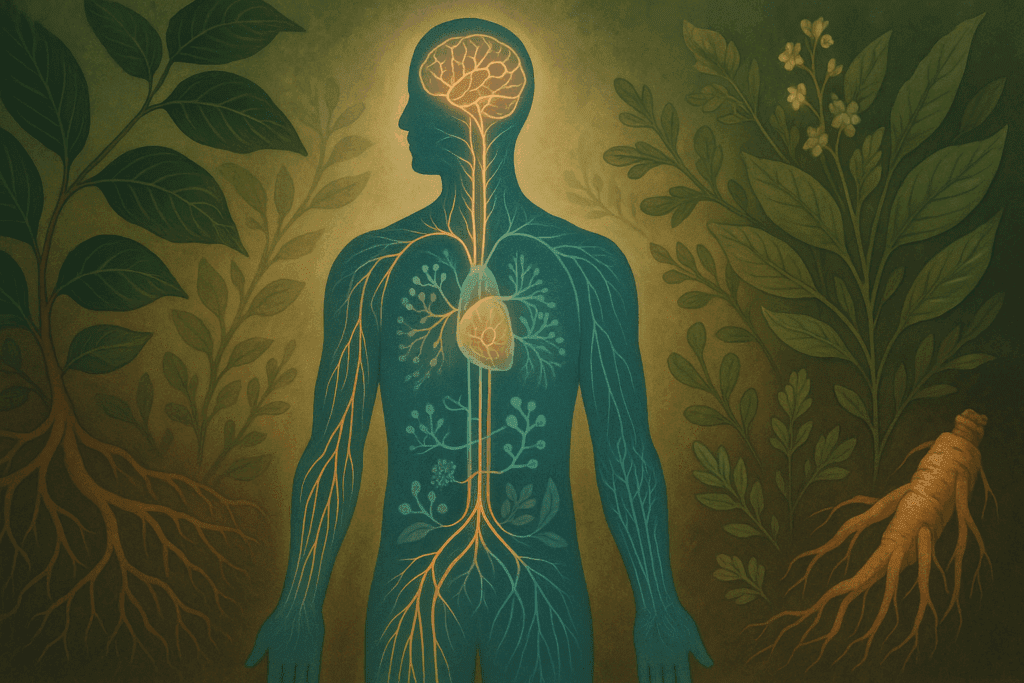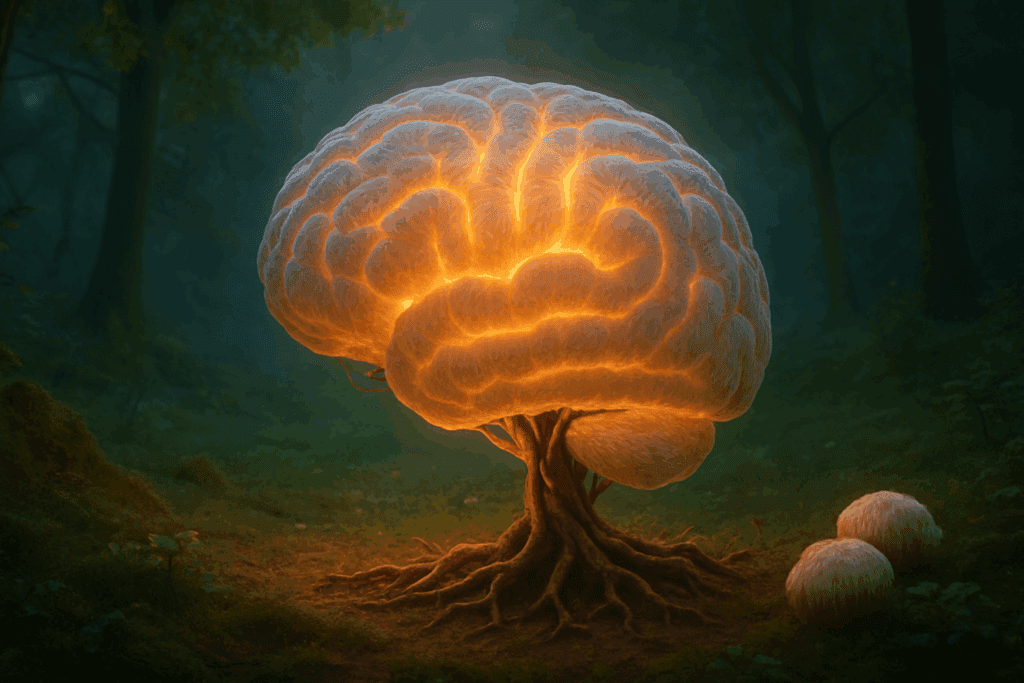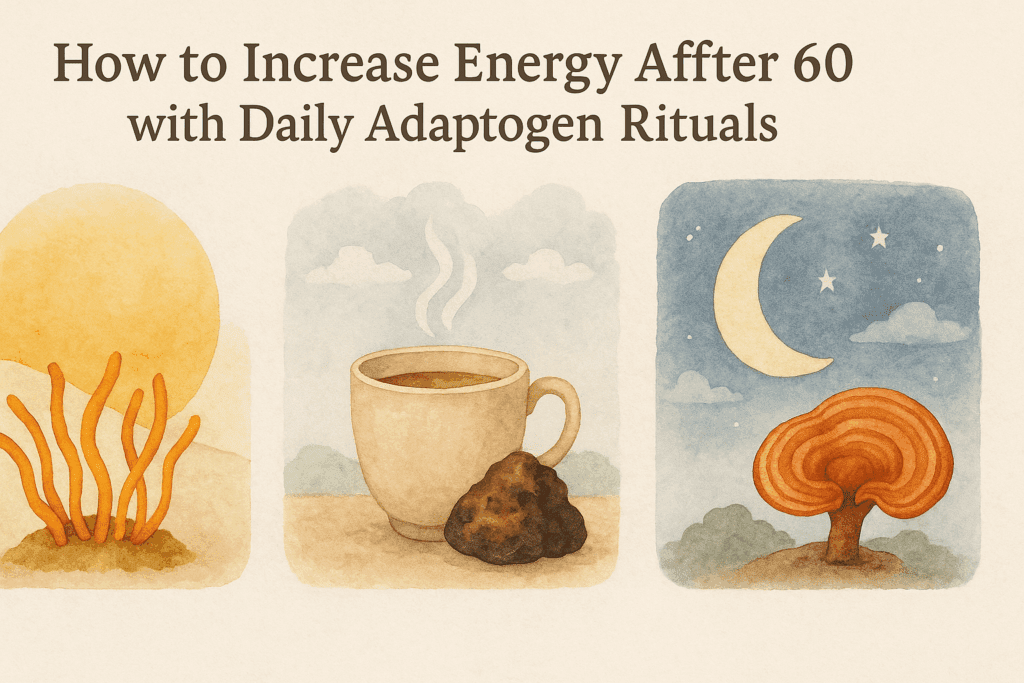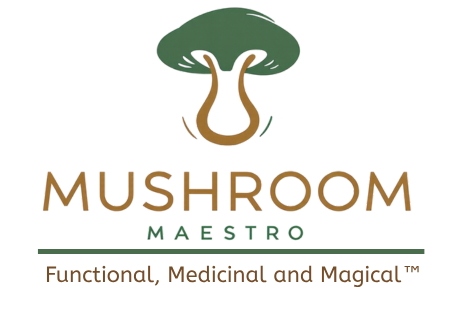As we grow older, many individuals find themselves looking for ways to support their well-being, vitality, and resilience against the cumulative effects of aging. For those specifically wondering how to increase energy after 60, adaptogenic mushrooms have emerged as a promising natural ally. With their long-standing presence in traditional medicine systems and increasing validation through modern research, these remarkable fungi offer both stress-relief and energy-boosting potential for those navigating life beyond the sixth decade.
You may also like: Unlock Powerful Stress-Relief with Adaptogenic Mushrooms and Stamina Herbal Support

Understanding Adaptogens: Nature’s Stress Modulators
Adaptogens are a class of natural substances known to help the body adapt to stress, restore balance, and maintain homeostasis. Unlike pharmaceutical interventions that target specific symptoms or systems, adaptogens work more holistically. They normalize physiological responses and help the body resist a wide range of stressors—be they physical, emotional, or environmental. When discussing how to increase energy after 60, it’s important to understand that energy isn’t just a function of physical stamina; it’s deeply tied to our body’s ability to maintain equilibrium under stress. By supporting adrenal function and reducing cortisol levels, adaptogens can alleviate the fatigue that often accompanies chronic stress.
Adaptogenic mushrooms such as Reishi, Cordyceps, Lion’s Mane, and Chaga are particularly renowned for their multifaceted benefits. These mushrooms are not only rich in polysaccharides, triterpenes, and antioxidants but also work synergistically with the nervous and endocrine systems. Incorporating these into a daily routine, especially after the age of 60, may provide a natural buffer against energy dips, mental fog, and stress-induced fatigue.

Reishi: The Calming Powerhouse for Restorative Balance
Often referred to as the “mushroom of immortality,” Reishi (Ganoderma lucidum) has a centuries-long history in traditional Chinese medicine. This deeply calming mushroom is well-suited for individuals dealing with chronic stress, anxiety, or insomnia—conditions that can severely deplete energy levels over time. For those exploring how to increase energy after 60, improving sleep quality and emotional resilience is foundational.
Reishi supports parasympathetic nervous system activity, promoting a state of rest and repair. It modulates the hypothalamic-pituitary-adrenal (HPA) axis, reducing the excessive cortisol production commonly associated with stress. Additionally, Reishi exhibits immunomodulatory properties that support the body’s ability to fend off age-related illnesses, which can otherwise drain energy reserves.
In practical terms, incorporating Reishi into a nightly routine—perhaps in the form of tea, tincture, or capsule—can enhance restorative sleep, promote a sense of calm, and set the stage for more consistent daytime energy.

Cordyceps: A Natural Energizer for Aging Muscles and Lungs
When it comes to physical vitality, few mushrooms are as energizing as Cordyceps (Cordyceps militaris and Cordyceps sinensis). Traditionally used in Himalayan medicine to enhance stamina and libido, Cordyceps is now backed by studies showing improved oxygen utilization, mitochondrial function, and exercise performance. For older adults seeking practical strategies on how to increase energy after 60, Cordyceps offers a compelling, evidence-based option.
Cordyceps enhances ATP (adenosine triphosphate) production—the molecular currency of energy in our cells. This is especially relevant for aging individuals, whose mitochondria often become less efficient with time. Furthermore, Cordyceps supports respiratory health by dilating airways and improving lung capacity, making physical activity less taxing and more enjoyable.
Whether added to smoothies, brewed in teas, or taken in capsule form, Cordyceps can be a valuable part of a holistic energy enhancement regimen for seniors. It provides not just a temporary boost, but a more sustained improvement in vitality and physical performance.

Lion’s Mane: Fuel for Cognitive Clarity and Emotional Energy
While physical stamina is crucial, mental energy is equally vital, especially as one crosses into later decades of life. Lion’s Mane (Hericium erinaceus) is a unique mushroom prized for its neuroregenerative properties. It stimulates the synthesis of Nerve Growth Factor (NGF), which supports the growth, maintenance, and survival of neurons. For those researching how to increase energy after 60, maintaining cognitive function is not just about memory but also mental sharpness and emotional resilience.
Declining energy levels in older adults are often linked to cognitive fatigue—difficulty focusing, mental fog, and reduced motivation. Lion’s Mane has demonstrated potential in enhancing mood, reducing symptoms of anxiety and depression, and improving overall brain function. These effects contribute indirectly but powerfully to increased energy levels, as mental clarity and emotional wellness often determine how energized one feels throughout the day.
Integrating Lion’s Mane into one’s diet—either through cooking with dried mushrooms, using powdered extracts, or taking supplements—can provide a daily lift in clarity and concentration. It acts not as a stimulant, but as a nourishing support system for the brain, making it particularly valuable for older adults.
Chaga: The Antioxidant Shield Against Fatigue
Chaga (Inonotus obliquus) grows primarily on birch trees in cold climates and is renowned for its dense concentration of antioxidants, especially melanin and polyphenols. This mushroom supports immune health, reduces inflammation, and combats oxidative stress—all of which are critical concerns in the aging population. Those exploring how to increase energy after 60 must consider the role of inflammation and cellular damage in sapping vitality.
Oxidative stress is known to impair mitochondrial function and accelerate aging processes. Chaga counters these effects by scavenging free radicals, improving antioxidant enzyme levels, and supporting healthy cellular function. Its adaptogenic nature also allows it to balance immune responses, which can become overactive or suppressed with age.
Regular consumption of Chaga tea or extracts may result in subtle but meaningful improvements in how energized and resilient one feels. While not a quick fix, Chaga offers long-term benefits that accumulate over weeks and months of consistent use.

How to Increase Energy After 60 with Daily Adaptogen Rituals
Incorporating adaptogenic mushrooms into daily life doesn’t have to be complicated. In fact, the most effective routines are often the simplest and most sustainable. Creating a morning ritual with Cordyceps and Lion’s Mane—perhaps in a coffee substitute or smoothie—can support mental and physical energy throughout the day. Reishi can be reserved for the evening, aiding in recovery and stress relief. Chaga may be used as a midday antioxidant tea to prevent energy crashes.
This multifaceted approach supports multiple aspects of energy regulation: neuroendocrine balance, immune function, mental clarity, and mitochondrial efficiency. For individuals looking into how to increase energy after 60, such rituals align with the body’s natural rhythms and address the root causes of fatigue, rather than just masking symptoms.

Nutrition, Sleep, and Lifestyle: Essential Foundations
While adaptogens offer powerful support, they are most effective when paired with a solid foundation of healthy lifestyle habits. Nutrition remains a cornerstone. Older adults should prioritize protein intake, healthy fats, and a variety of colorful vegetables to ensure micronutrient sufficiency. B vitamins, magnesium, and CoQ10 are particularly important for cellular energy production. Incorporating fermented foods can further support gut health, which in turn influences energy levels and mood.
Sleep hygiene also plays a critical role. Establishing consistent sleep and wake times, limiting blue light exposure at night, and engaging in calming evening routines can greatly enhance restorative sleep. Since poor sleep is one of the most common yet overlooked causes of low energy, this area deserves focused attention.
Movement, too, is non-negotiable. Gentle exercise such as walking, tai chi, or resistance training not only boosts physical stamina but also enhances mood and reduces inflammation. These habits work synergistically with adaptogens to improve how one feels and functions each day.
The Psychology of Aging and Perceived Energy
It is important to acknowledge that energy is not just a biological construct but also a psychological one. How energized a person feels is influenced by mood, mindset, and motivation. Positive social interactions, a sense of purpose, and engagement in meaningful activities can greatly uplift perceived energy levels. In this light, addressing how to increase energy after 60 also means nurturing emotional and social well-being.
Practices like mindfulness meditation, journaling, and creative expression help regulate the nervous system and encourage a positive outlook. Adaptogenic mushrooms may support these efforts by stabilizing mood and reducing stress reactivity, but they are most powerful when part of a broader commitment to holistic self-care.
How Can I Boost My Energy After 60? A Synergistic Answer
The question “how can I boost my energy after 60” deserves a multidimensional answer. There is no single silver bullet, but rather a constellation of lifestyle shifts, nutritional upgrades, and natural supports that work together. Adaptogenic mushrooms offer an extraordinary bridge between ancient healing wisdom and modern health science, helping the body return to balance and resilience.
Cordyceps fuels the mitochondria, enhancing physical stamina. Lion’s Mane supports neurogenesis and mental acuity. Reishi calms the mind, reduces cortisol, and promotes restorative rest. Chaga shields cells from oxidative damage, supporting longevity. When combined with mindful eating, restful sleep, regular movement, and meaningful connection, these mushrooms become part of a synergistic strategy for reclaiming vitality in later life.
How to Increase Energy After 60 with Neuroendocrine Support
One of the most overlooked aspects of energy management in older adults is the role of the neuroendocrine system. This complex network of hormone-producing glands interacts directly with the nervous system to regulate mood, metabolism, and energy expenditure. As we age, shifts in hormone levels—such as thyroid, cortisol, DHEA, and insulin—can create imbalances that manifest as fatigue, brain fog, or reduced stamina.
Adaptogens, by definition, help modulate the stress response system and restore hormonal balance. Reishi’s ability to down-regulate excessive cortisol production, for example, can protect against adrenal exhaustion—a condition that, while not always clinically defined, is increasingly recognized in functional medicine circles. Cordyceps may enhance androgen production, including testosterone and DHEA, which play roles in libido and muscle tone. Lion’s Mane, through its neurotrophic actions, supports the delicate dance between neurotransmitters and hormones.
For those seeking practical ways on how to increase energy after 60, addressing neuroendocrine health with adaptogenic support represents a key, often missing, piece of the puzzle. Consulting with an integrative practitioner to monitor hormone levels and tailor a personalized approach may be particularly beneficial.
The Role of Inflammation in Energy Depletion
Chronic inflammation is another silent saboteur of energy in older adults. Conditions like arthritis, cardiovascular disease, and even subclinical inflammation associated with metabolic syndrome can drain energy at a cellular level. Inflammatory cytokines interfere with mitochondrial function and can disrupt normal neurotransmitter activity, contributing to both physical and mental fatigue.
Adaptogenic mushrooms—particularly Chaga and Reishi—possess potent anti-inflammatory properties. By modulating immune activity and reducing systemic inflammation, these mushrooms support more efficient cellular energy production and improve overall resilience. This effect is not immediate, but rather cumulative, highlighting the importance of consistency and long-term integration into one’s wellness routine.
Incorporating additional anti-inflammatory strategies—such as omega-3 rich foods, turmeric, green tea, and regular movement—further amplifies the energy-enhancing benefits of adaptogens. The question of how to increase energy after 60 is best answered by addressing the underlying inflammatory load that the body carries.
How to Increase Energy After 60 by Reclaiming Circadian Rhythms
One of the subtle yet significant factors in age-related energy decline is the disruption of circadian rhythms. These internal biological clocks regulate sleep-wake cycles, hormone secretion, digestion, and even gene expression. As we age, circadian rhythms often become desynchronized due to light exposure, poor sleep, irregular eating patterns, or lack of morning sunlight.
Adaptogenic mushrooms can help stabilize circadian function indirectly by modulating stress hormones and improving sleep quality. Reishi, for example, enhances non-REM sleep and supports melatonin production. Cordyceps provides energy without overstimulation, avoiding the crash-and-burn cycle of caffeine. Integrating these adaptogens into a lifestyle that respects natural light cycles, consistent routines, and time-restricted eating can restore harmony to circadian rhythms.
For those exploring how to increase energy after 60, aligning with the body’s natural time cues—waking with the sun, winding down at dusk, and honoring the need for rest—can lead to profound shifts in vitality and mood.
Frequently Asked Questions (FAQ) on Adaptogenic Mushrooms, Stress Relief, and Energy Optimization After 60
1. How can I tailor an adaptogenic mushroom regimen to meet my personal energy needs after 60?
Personalizing an adaptogenic protocol requires evaluating your specific energy patterns, stress response, sleep quality, and cognitive clarity. For example, if you experience morning sluggishness but remain alert at night, you may benefit from taking Cordyceps in the morning and Reishi in the evening to align with your circadian rhythms. A functional health coach can help monitor how your adrenal and thyroid health are affecting energy output and adjust dosages or combinations accordingly. For mental fatigue, a focus on Lion’s Mane—especially in combination with omega-3-rich foods—may enhance neuroplasticity and memory recall over time. Keeping a journal to track your energy levels throughout the day can reveal trends that help optimize your adaptogen timing and selection.
2. Can adaptogenic mushrooms be combined with conventional medications or therapies?
While adaptogens are generally safe, they can sometimes interact with medications that affect blood pressure, immune modulation, or hormone regulation. If you’re undergoing treatment for chronic conditions such as diabetes, hypertension, or autoimmune disorders, it’s essential to consult your healthcare provider before introducing medicinal mushrooms. For example, Reishi has mild anticoagulant properties and may amplify the effect of blood thinners, whereas Cordyceps could potentially interact with immunosuppressive drugs. Integrative practitioners can help create a balanced protocol where adaptogens complement—not conflict with—conventional treatments. Lab monitoring can further ensure there are no unintended interactions as your body adjusts to the new regimen.
3. Are there gender-specific differences in how to increase energy after 60 using adaptogens?
Yes, hormonal differences in aging men and women can influence how adaptogens affect energy restoration. For postmenopausal women, Reishi and Chaga may offer immune and hormone-balancing effects that help ease fatigue linked to estrogen decline. Men over 60 may benefit more from Cordyceps, which has shown mild support for testosterone levels and muscular endurance. Lion’s Mane is equally effective for both sexes in enhancing cognitive performance and mood. However, gender-responsive dosing and tracking of hormonal biomarkers, such as cortisol, DHEA, and estrogen/testosterone ratios, can significantly refine the adaptogenic strategy for optimal energy support in later years.
4. How can I boost my energy after 60 through seasonal adaptogen rotation?
One of the lesser-known techniques for sustaining adaptogenic benefits is rotating mushrooms seasonally to match the body’s shifting needs. During winter months, Chaga and Reishi help fortify immune resilience and support restful sleep, which is often disrupted by decreased daylight. In spring and summer, Cordyceps can be emphasized to align with increased physical activity and outdoor movement, helping maximize ATP production and oxygen efficiency. Lion’s Mane may be prioritized during periods of heightened mental workload or emotional transition, such as post-retirement planning or grandparenting responsibilities. This seasonal approach prevents adaptation fatigue, ensuring that your body continues to respond effectively to each mushroom’s unique benefits.
5. What daily lifestyle shifts complement adaptogenic mushrooms to help maintain energy after 60?
While adaptogens offer biochemical support, they work best alongside lifestyle adjustments that optimize energy metabolism. Morning sunlight exposure supports circadian rhythm alignment and improves cortisol awakening response, which sets the tone for consistent daytime energy. Intermittent movement—such as standing, stretching, or walking every hour—stimulates lymphatic flow and oxygen delivery, enhancing mitochondrial efficiency. Anti-inflammatory meals rich in leafy greens, wild-caught fish, and fermented foods also contribute to cellular energy and gut-brain axis health. Adaptogens amplify these effects by regulating neuroendocrine and immune responses, but they are most effective when these foundational habits are in place and practiced consistently.
6. How can I monitor whether adaptogens are actually helping with energy and stress relief?
Rather than relying solely on subjective feelings, tracking objective markers can give a clearer picture of progress. Wearable devices that monitor heart rate variability (HRV), sleep quality, and daily steps can indicate improved stress resilience and physical stamina. Regular lab tests for cortisol levels, vitamin D status, and thyroid function can also reveal whether adaptogens are influencing hormonal and metabolic pathways linked to fatigue. Additionally, keeping a detailed wellness journal that logs mood, focus, sleep, and physical energy over time helps identify subtle patterns. Reviewing these insights monthly allows for refinement of your adaptogen regimen and related habits.
7. How does stress influence energy metabolism, and can adaptogens help break the cycle?
Chronic stress leads to prolonged activation of the hypothalamic-pituitary-adrenal (HPA) axis, resulting in elevated cortisol levels that eventually disrupt glucose metabolism, sleep, and mitochondrial function. This cascade significantly reduces the body’s ability to generate sustainable energy, especially after age 60 when hormonal plasticity declines. Adaptogens help by normalizing HPA activity, preventing the overproduction of stress hormones, and supporting adrenal recovery. This regulatory effect can improve both immediate energy levels and long-term metabolic stability. Pairing adaptogens with relaxation techniques like breathwork or restorative yoga accelerates the unwinding of this stress-energy imbalance.
8. What are the dangers of relying on caffeine or sugar to boost energy after 60, and how do adaptogens offer a safer alternative?
While caffeine and sugar provide short-term energy spikes, they often lead to crashes that compound fatigue and disrupt blood sugar regulation. Over time, excessive reliance on stimulants can contribute to insulin resistance, disrupted sleep patterns, and adrenal overdrive. After 60, the body becomes more sensitive to these fluctuations, making it harder to recover from overstimulation. Adaptogens offer a balanced, non-stimulating alternative by working with the body’s stress and energy systems rather than overriding them. For example, Cordyceps enhances mitochondrial output without causing jitteriness, while Reishi promotes calm alertness by modulating neurotransmitters like GABA and serotonin.
9. How to increase energy after 50 in ways that continue to work into your 60s and beyond?
Establishing energy-boosting habits in your 50s sets the groundwork for sustained vitality in your 60s and 70s. The key is to focus on mitochondrial health, hormonal harmony, and cognitive preservation rather than temporary energy solutions. Incorporating adaptogens like Lion’s Mane early can promote long-term neurogenesis, while Cordyceps supports muscle metabolism even as activity levels shift with age. Regular strength training and HIIT-style movement maintain muscle mass and metabolic rate, both of which decline rapidly after 50 without intervention. Tracking progress with tools like DEXA scans and metabolic assessments can help refine your strategy so it evolves with your changing physiology.
10. How can I boost my energy after 60 if I’ve already tried conventional approaches like multivitamins and better sleep?
If traditional methods haven’t delivered the desired results, it may be time to explore emerging solutions such as adaptogen stacking, chronobiology-based eating, and personalized peptide therapies. Stacking refers to combining multiple adaptogens based on their complementary effects—like pairing Cordyceps for physical energy with Lion’s Mane for mental clarity. Eating in alignment with your circadian clock—heavy meals earlier in the day, lighter meals at night—improves metabolic efficiency and sleep. Novel therapies like BPC-157 and mitochondrial-boosting peptides are gaining traction in functional medicine for their regenerative potential. Consulting a longevity-focused practitioner can help tailor these advanced strategies to your unique bio-profile, especially when asking how to increase energy after 60 in a more targeted, high-impact way.
A Holistic Answer to How to Increase Energy After 60
Ultimately, the journey to increase energy after 60 is about more than managing fatigue—it is about cultivating vitality, purpose, and joy in the second half of life. Adaptogenic mushrooms offer a uniquely versatile tool in this endeavor, addressing the biochemical, neurological, and emotional layers of energy regulation. They act as allies, not replacements, for the foundational pillars of health: nourishing food, restorative rest, movement, and meaningful connection.
Whether through Cordyceps-powered mornings, Lion’s Mane-fueled focus, Reishi-inspired calm, or Chaga-supported defense, the daily use of adaptogens becomes a ritual of self-respect and renewal. It invites older adults to not merely cope with the limitations of aging, but to thrive within their changing bodies.
By honoring both the science and the spirit of these mushrooms, we discover that energy is not something to be chased, but something to be nurtured—and that even after 60, there are powerful, natural ways to feel vibrant, awake, and alive.
Further Reading:
9 Unexpected Energy Boosters for Older Adults
